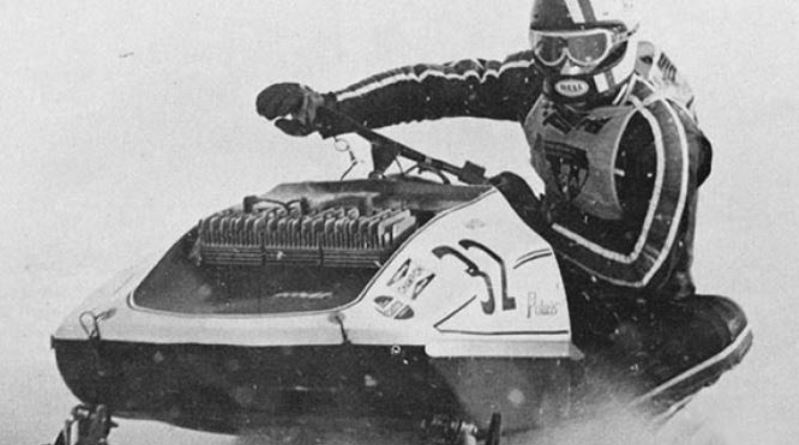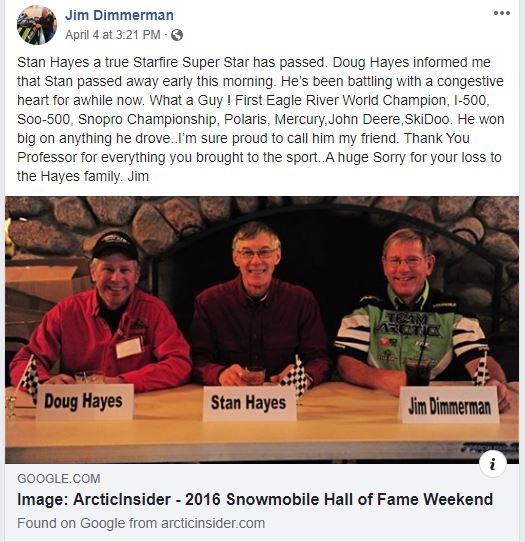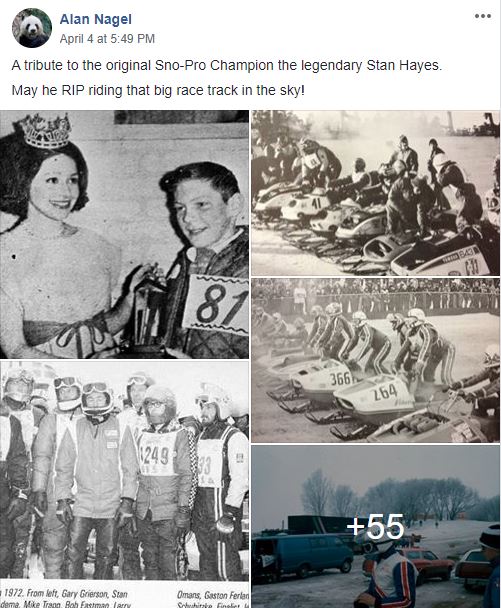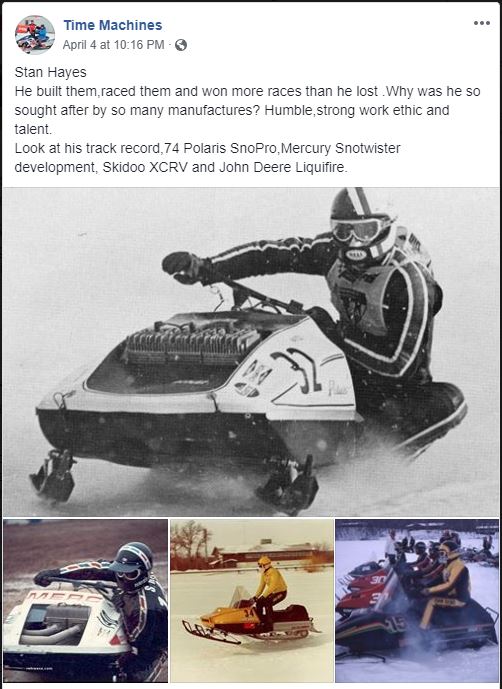Stan Hayes, one of the most legendary names in all of snowmobile racing, died on the morning of Saturday, April 4, while hospitalized in Rochester, Minnesota. He was 69 and suffering from heart disease.

Hayes initially earned notoriety as a young teenager – credited with winning the very first Eagle River World Championship in 1964. That was just the beginning, however: Hayes is known for winning snowmobile racing’s unofficial “triple crown” after also claiming first place in the Soo I-500 in Michigan twice (1972 & 1976) and in the cross-country I-500 (1973).
Beyond his prowesss behind a handlebar, he also made a huge impact with his engineering background with clutching and suspension setup and development in particular. His racing career spanned 26 years and included oval, enduro and cross-country racing.
Close friends, though, remembered a reserved, soft-spoken and highly intelligence who earned the nickname “the professor” for his ability to diagnose situation and his serious approach to his craft.
Fellow Hall of Famer Gerard Karpik got to watch and later race with Stan Hayes, and he considers him one of the sport’s greatest racers ever.
“In the world of racing, there were two ‘greats’ that stand out to me,” Karpik said. “Tucker Hibbert is one and Stan Hayes is the other. Stan was a racer who covered the field: He was our first World Champion at Eagle River, our first Sno Pro champion when Sno Pro was the thing to do – it was bigger than snocross ever got back then – he won the Soo 500 twice and he won the I-500. He did everything… Until I broke through and got some support, I was always a wanna-be, and the wanna-be that I had was Stan Hayes: That’s who I wanted to be!”
Tribute to Hayes could be found all over social media over the weekend.

Stan Was The Man
Racing was in the blood of the Hayes boys – father George got sons Stan and Doug Hayes involved in racing at young ages. George, in fact, was a founding member of the USSA in the late 1960.
Stan’s victory on Dollar Lake at the first Eagle River World Championship in 1964 is looked back upon by some historians as rather quaint – the Derby was a family-oriented first-time event back then and, according to legend, after the event organizers picked Hayes as overall champion to feed the press an interesting story. Then a 13-year-old eighth grader from nearby Crandon, Hayes did win one class that day – the over 9 hp “cross-country” event that was less than a mile long – on a borrowed 13 horsepower Polaris. Allegedly, that day was the first time he had ridden a snowmobile.
He went on to prove that he was no fluke, though, becoming one of the truly legendary figures in snowmobile racing. He competed for awhile on Ski-Doos before moving back to Polaris sleds and, according to longtime USSA leader Jerry Korinek, Stan became a go-to guy for racers seeking advice.
“With Polaris then, there was a ‘Roseau crowd’ so Stan was seen as a bit of an outsider, but he so profound in what he did, they followed him,” Korinek recalled in an interview this morning. “If you ran into a problem, like if it isn’t coming off the line well or not coming out of the corner the way it should, people would say, ‘Well, go ask the professor, he’ll tell you what to do.’”
Korinek added, “Back then people didn’t realize how suspension really worked, but Stan, because of his background and education, had a better comprehension of angles and weight transfer and what we now call roll center and things like that. He knew what he was doing there – he had a real natural feel and the intelligence for such things.”

Stan and Doug Hayes teamed with LuVern Hagen to win their first Soo I-500 in Sault Ste. Marie, Michigan, in 1972 on a Polaris, and then in 1976 the Hayes boys teams with Jerry Witt to earn victory again on a Mercury. In between those historic victories, Stan won a weather-shorted cross-country I-500 in 1973 on a Polaris – running the old Winnipeg-to-St. Paul route, the race that year ended in Alexandria, Minnesota due to freezing fog – and was the first Sno Pro season champion when that became the preferred form of oval racing in 1974.
He was sought by other factories, though, as much for his smarts as his driving skill. He was lured away by Mercury and is credited for helping develop the Sno Twister, then moved back to Ski-Doo where he worked with a star-studded crew and is credited with helping develop the cross-country RV while also leading the racing effort out of a Ski-Doo-supported performance shop in Virginia, Minnesota.
“He had developed race craft to a point where it was formalized,” Karpik said. “Stan knew exactly how to run a factory race team. [With sled development and setup] everything was methodically worked out, there had to be a reason why this behaved like that – you never got the result without the hard work when you worked with Stan Hayes: tests were made, tests were recorded. I’ve still got my test notebooks to this day stored away, they are that important to me.
Stan’s long-time home, though, would be at the Horicon, Wisconsin, John Deere facility – that’s where he had a long and illustrious career that stretched for more than 40 years in engineering, sticking around long after Deere left the snowmobile market to be involved in all sorts of agricultural equipment.

Though his outward nickname was “the professor,” the world “gentleman” comes up often when people talk about Stan Hayes. His calm demeanor his the competitive spirit that made him a champion in everything he did.
“He was always very courteous and a true gentleman,” said Tom Anderson, founder of the Snowmobile USA show and World Snowmobile Headquarters and co-owner of the Derby Track in Eagle River since 2017. “When he was racing, Stan was a quiet, studious guy – a mild-mannered person who was not flamboyant.”
Hall Of Famer
Stan Hayes was inducted into the Snowmobile Hall of Fame – then called the Snowmobile Racing Hall of Fame – in 1988. His bio from the Hall Of Fame includes these words:
“A designer, a technician as well as a racer, Stan was instrumental in the development of the second generation Mercury Sno-Twister in the middle 1970s as well as the second generation Fire Series at John Deere in the late 1970s and early 1980s.
“Stan was working on the IFS Liquifire project when John Deere pulled the plug on snowmobile operations in 1984. Stan’s last race was the 1990 Harricana cross-country Race which was a 3 man team race. It ran 1,500 miles across the province of Quebec over a period of 10 days. Stan’s team finished in second place only 27 seconds behind the winning time.”
Editor’s Note: Every Snow Goer issue includes in-depth sled reports and comparisons, aftermarket gear and accessories reviews, riding destination articles, do-it-yourself repair information, snowmobile technology and more. Subscribe to Snow Goer now to receive print and/or digital issues.
